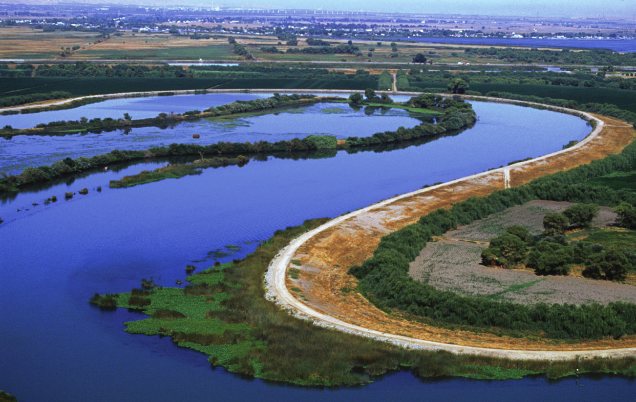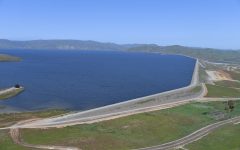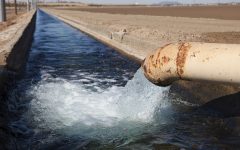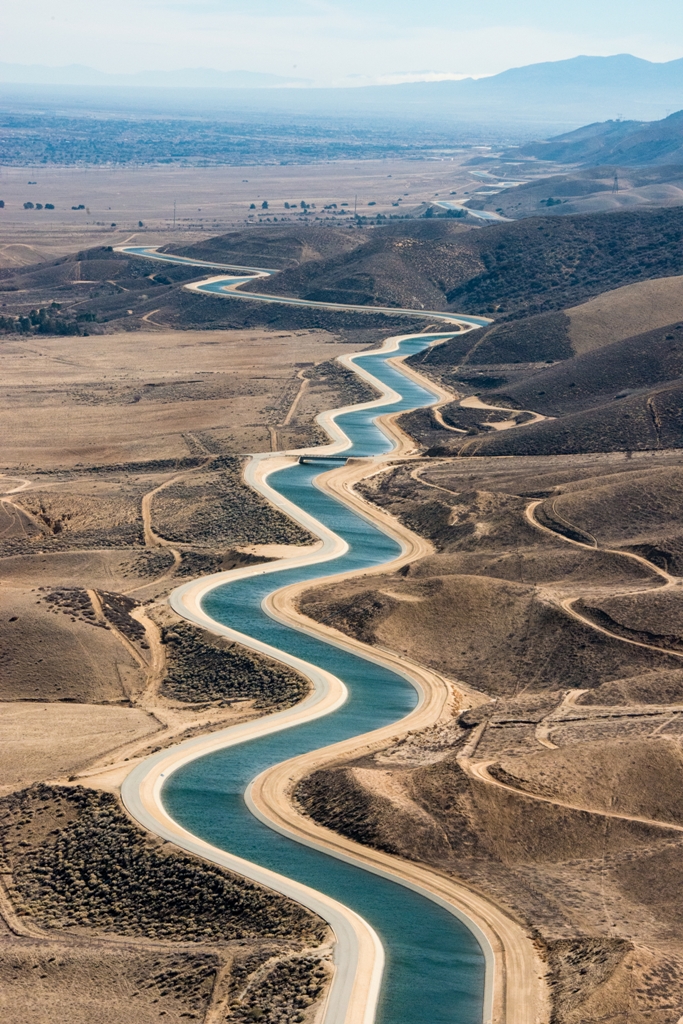
California Bay Delta water (Photo: USGS.gov)
Ringside: Water Czars Ignore Solutions to Scarcity
Rainfall and the snowpack are not diminishing nearly as fast as the regulatory appetite to restrict water withdrawals is increasing
By Edward Ring, May 9, 2024 2:55 am
 The Delta Tunnel proposal exemplifies California’s political dysfunction. It will probably never get built, but it promises to dominate all discussions of major state and federal spending on water infrastructure for the next decade, preventing any other big ideas from getting the attention they merit.
The Delta Tunnel proposal exemplifies California’s political dysfunction. It will probably never get built, but it promises to dominate all discussions of major state and federal spending on water infrastructure for the next decade, preventing any other big ideas from getting the attention they merit.
Like the bullet train and offshore wind, it is a grandiose megaproject that checks all the political boxes while flunking any reasonable cost/benefit analysis. But it creates jobs for California’s construction trades union members at the same time as it manages to keep California’s environmentalist lobby neutral if not actually supportive. Why would anyone take on the state’s all powerful environmentalists if they didn’t have to? And thanks to the remaining environmentalist groups that will oppose the Delta Tunnel no matter what, expect endless litigation.
If the Delta Tunnel is ever completed, say sometime around 2050 or 2060, after costing — let’s be real — $30 billion or more (in 2024 dollars) it will move 500,000 acre feet of water per year, which is nothing. California’s farmers require 30 million acre feet per year; its cities, around 8 million acre feet per year. If it gets built, then every year activist regulators and environmentalist litigators will ensure that getting that 500,000 acre feet through the tunnel will be a perennial battle. And they will see to it that to the extent water does flow through the tunnel, comparable amounts of water will no longer be moved using the existing pumps located northwest of Tracy.
All that time. All that money. All that cement! For nothing.
The California Department of Water Resources controls the output of the Banks Pumping Plant, which at full capacity can move 20,000 acre feet per day into the California Aqueduct from the Sacramento-San Joaquin Delta. This agency decides how much water actually moves into the aqueduct, and every chance they get, they lower the flow. When storms were pouring over 100,000 acre feet of fresh water per day out of the Delta and into the San Francisco Bay this past January, this agency turned the pumps down to 10 percent of their capacity, based on a concern for fish getting trapped in the pumps. Today, as Sierra snowmelt promises to raise the flow for a few more months, this agency has again throttled down the pumps, again to protect fish. Water agencies served by the State Water Project are still only at 40 percent of their contracted allocation this year, despite California just exiting its second very wet winter in a row.
For California’s water consumers, this is the new political reality. Rainfall isn’t diminishing, nor is the snowpack, nearly as fast as the regulatory appetite to restrict water withdrawals is increasing. Up until around 2000, State Water Project deliveries were always 100 percent of the contracted amount as long as rainfall totals were anywhere near normal. But in California today, the environmentalists pretend introduced predators aren’t the biggest problem with our native fish populations, in return for sport fishing interests pretending that year-round river flows even in drought years are necessary for species survival. And when farmers object, cue the activist journalists to demonize “big ag.” Never mind that it’s always the smaller farms, delivering diverse produce, that are the first to go when another manmade drought arrives.
There are so many better ways to spend $30 billion (or more) on water projects that it boggles the mind. For $30 billion, we could build plants with a combined capacity to desalinate a million acre feet per year, and the energy required to do it would be no more than is currently required to operate the six pumping stations that move water from the Delta to the Los Angeles Basin. You could probably construct treatment plants to purify and reuse about a million acre feet of urban wastewater for that amount of money. Or you could build the Pacheco, Sites, Del Puerto, and Temperance Flat Reservoirs and raise the Shasta Dam, yielding around 1.5 million acre feet per year (or more), and still have $10-$15 billion left over to repair and upgrade California’s levees and aqueducts – something that has to be done no matter what.
One massively powerful entity committed to the “Delta Conveyance” is the Metropolitan Water District of Southern California. It is the largest water supplier in the United States, serving nearly 20 million people. If the Met were an oak tree, it would be a gargantuan lone oak in a forest of shrubbery. And the Met has sown its acorns, almost every one of them, in the uncertain soils of the Delta Conveyance. If that soil grows parched beneath the blistering sun of litigation, or lacks sufficient fertilizer in the form of funding, or is revealed by a rational financial analysis to be nonarable, all those acorns will die. Why not allocate just a few acorns to something else, and see if they grow?
The concept of fish friendly delta diversions remains alive and well, but underfunded and virtually ignored. Until this concept is proven impossible – and only for the right reasons, if there are any – it ought to be a priority for Met, for the Dept. of Water Resources, for the state Legislature, and for the governor. Allowing water to settle into perforated pipes set in channels cut in an island in the central delta would not alter the east-to-west flow of the delta. It wouldn’t trap fish. It could operate all year long, and could have surge capacity to take those elusive “big gulps” when winter storms and spring snowmelt swell the flow. Engineering studies so far indicate a 200 acre filtration channel could safely move up to 15,000 acre feet per day into southbound aqueducts and into quick charge aquifers.
It is the responsibility of California’s water czars to provide abundant water to the state’s cities and farms. They are not obligated to bleat planetary platitudes to justify rationing and paralysis, nor to excuse their support for yet another prodigious, epic, tragic, scandalous, stupefying waste of tens of billions of dollars. Not when alternatives exist that might actually address the concerns of literally every reasonable observer, whether they are sincere environmentalists, union leaders committed to securing new projects for their members, the millions of Californians who depend on healthy fishing and farming industries, or anyone else for whom abundant and affordable water is a right and a necessity.
- Ringside: Will the Delta Pumps Operate at Capacity this Winter? - December 18, 2025
- Ringside: Will Advocates for More Water Supply Projects Find Unity? - December 11, 2025
- Ringside: EVs and California’s Future Demand for Electricity - December 4, 2025





When will the California Department of Water Resources take the sage advice of Edward Ring?
Time and time again he addresses the problems and comes up with solid solutions!
Scarcity and control is their goal not a problem to be overcome.
It is time to start talking about Big Green and the total corruption and depopulation agenda that drives it.
Totally….
Expose this fraudulent boondoggle…
Period. Full Stop…
“It is the responsibility of California’s water czars to provide abundant water to the state’s cities and farms. ”
Quick someone PLEASE tell this to Newsom and his water-wasting minions…
Period. Full Stop.
No one voted for these unelected bureaucrat stooges who act like petty czars who are willingly promoting water scarcity and willingly ignoring solutions that Mr. RIng and others have repeatedly suggested. Maybe these “czars” need to be overthrown like the czar was overthrown in Russia? Name and shame them:
Board Chair: E. Joaquin Esquivel (Appointed by Newsom, B.A. in English, Democrat party hack)
Vice Chair: Dorene D’Adamo
Board Members: Nichole Morgan, Laurel Firestone, Sean Maguire